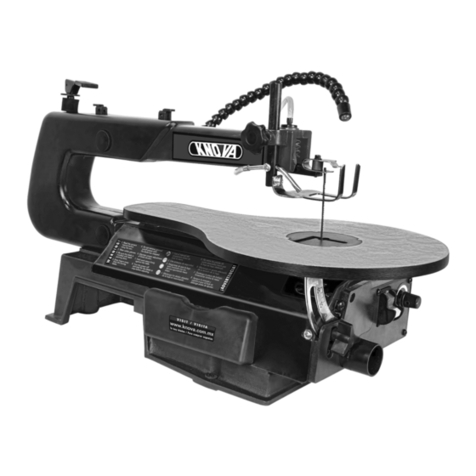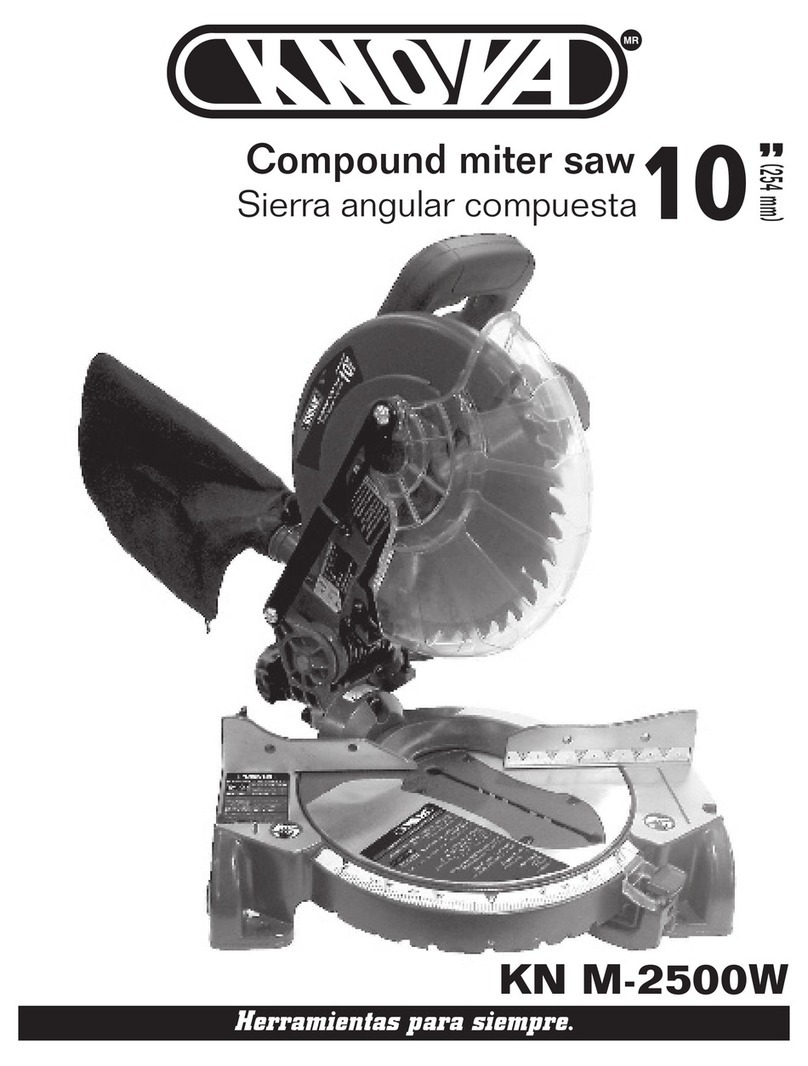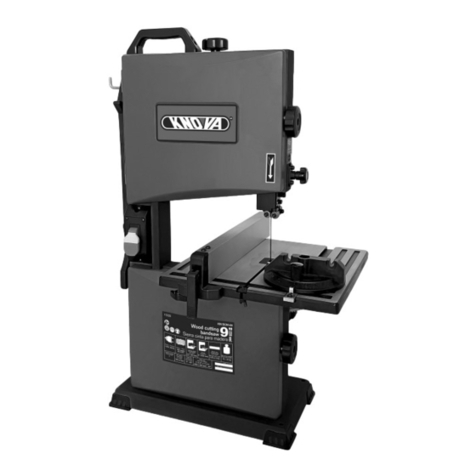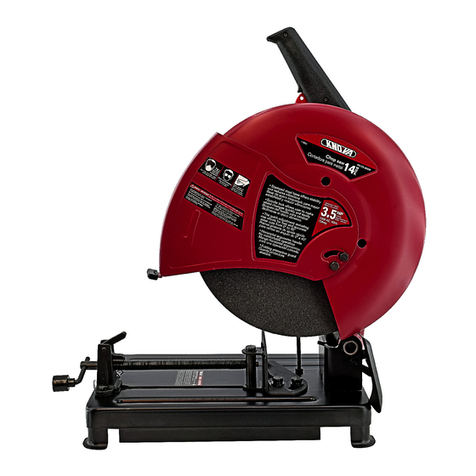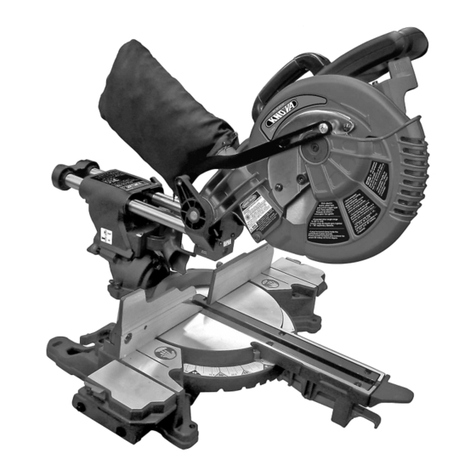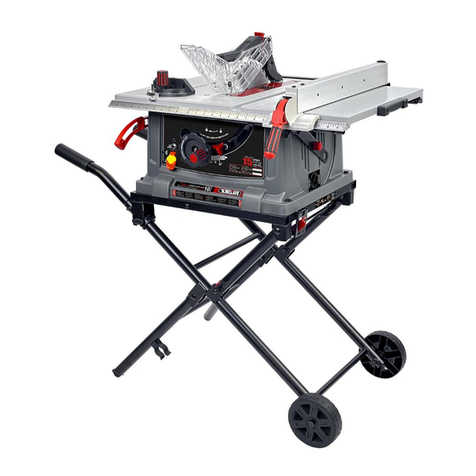
TABLE SAW SAFETY
SAW BLADE GUARD ASSEMBLY, ANTIKICKBACK
ASSEMBLY AND RIVING KNIFE
Your table saw is equipped with a blade guard assembly, anti-
kickback assembly and riving knife that covers the blade and
reduces the possibility of accidental blade contact. The riving
knife is a at plate that ts into the cut made by the saw blade
and effectively ghts kickback by lessening the tendency of
the blade to bind in the cut.
The blade guard assembly and antikickback assembly can
only be used when making through cuts that sever the wood.
When making rabbets and other cuts that make non through
cuts, the blade guard assembly and anti-kickback assembly
must be removed and riving knife lowered to the non through
cut position marked on the riving knife. Two anti-kickback
pawls are located on the sides of the riving knife that allow
the wood to pass through the blade in the cutting direction
but reduce the possibility of the material being thrown back-
wards toward the operator.
Use all components of the guarding system (blade guard
assembly, riving knife and antikickback assembly) for every
operation for which they can be used including all through
cutting.
If you elect not to use any of these components for a particu-
lar application exercise additional caution regarding control
of the workpiece, the use of push sticks, the position of your
hands relative to the blade, the use of safety glasses, the
means to avoid kickback and all other warnings contained in
this manual and on the saw itself.
Replace the guarding systems as soon as you return to thru-
cutting operations. Keep the guard assembly in working order.
KICKBACKS
KICKBACKS: Kickbacks can cause serious injury. A kickback
occurs when a part of the workpiece binds between the saw
blade and the rip fence, or other xed object, and rises from
the table and is thrown toward the operator. Kickbacks can be
avoided by attention to the following conditions.
How to avoid them and protect yourself from possible injury:
a. Be certain that the rip fence is parallel to the saw blade.
b. Do not rip by applying the feed force to the section of the
workpiece that will become the cut-off (free) piece. Feed
force when ripping should always be applied between the
saw blade and the fence; use a push stick for narrow
work, 6 in. (152 mm) wide or less.
c. Keep saw blade guard assembly, riving knife and anti-kick-
back assembly in place and operating properly. If
anti-kickback assembly is not operational, return your
unit to the nearest authorized service center for repair.
The riving knife must be in alignment with the saw blade
and the anti-kickback assembly must stop a kickback once
it has started. Check their action before ripping by
pushing the wood under the anti-kickback assembly.
The teeth must prevent the wood from being pulled
toward the front of the saw.
d. Plastic and composite (like hardboard) materials may be
cut on your saw. However, since these are usually quite
hard and slippery, the anti-kickback pawls may not stop a
kickback. Therefore, be especially attentive to following
proper set up and cutting procedures for ripping.
e. Use saw blade guard assembly, anti-kickback assembly
and riving knife for every operation for which it can be
used, including all through-sawing.
f. Push the workpiece past the saw blade prior to release.
g. Never rip a workpiece that is twisted or warped, or does
not have a straight edge to guide along the fence.
h. Never saw a large workpiece that cannot be controlled.
i. Never use the fence as a guide or length stop when
crosscutting.
j. Never saw a workpiece with loose knots, aws, nails or
other foreign objects.
k. Never rip a workpiece shorter than 10 in. (254 mm).
l. NEVER use a dull blade – replace or have resharpened.
m. NEVER use a rip fence and miter gauge together.
n. Keep hands out of saw blade.
ELECTRICAL REQUIREMENTS AND SAFETY
GROUNDING INSTRUCTIONS
IN THE EVENT OF A MALFUNCTION OR BREAKDOWN,
grounding provides a path of least resistance for electric
currents and reduces the risk of electric shock. This tool is
equipped with an electrical cord that has an equipment-
grounding conductor and a grounding plug. The plug must be
plugged into a matching receptacle that is properly installed
and grounded in accordance with all local codes and ordinances.
DO NOT MODIFY THE PLUG PROVIDED. If it will not t the
receptacle, have the proper receptacle installed by a qualied
electrician.
IMPROPER CONNECTION of the equipment grounding con-
ductor can result in risk of electric shock. The conductor with
the green insulation (with or without yellow stripes) is the
equipment grounding conductor. If repair or replacement of
the electrical cord or plug is necessary, do not connect the
equipment grounding conductor to a live terminal.
CHECK with a qualied electrician or service person if you do
not completely understand the grounding instructions, or if
you are not certain the tool is properly grounded.
USE only three-wire extension cords that have three-pronged
grounding plugs with three-pole receptacles that accept the
tool’s plug. Repair or replace damaged or worn cords imme-
diately.
GUIDELINES FOR EXTENSION CORDS
USE THE PROPER EXTENSION CORD.
Make sure your extension cord is in good condition. Use an
extension cord heavy enough to carry the current your pro-
duct will draw. An undersized cord will cause a drop in line
voltage resulting in loss of power, overheating and burning
out of the motor.
The table on page 5 shows the correct size to use depending
on cord length and nameplate ampere rating. If in doubt, use
the next heavier gauge. The smaller the
gauge number, the heavier the cord.
Make sure your extension cord is properly wired and in good
condition. Always replace a damaged extension cord or have
it repaired by a qualied technician before using it. Protect
your extension cords from sharp objects, excessive heat and
damp or wet areas.
4
